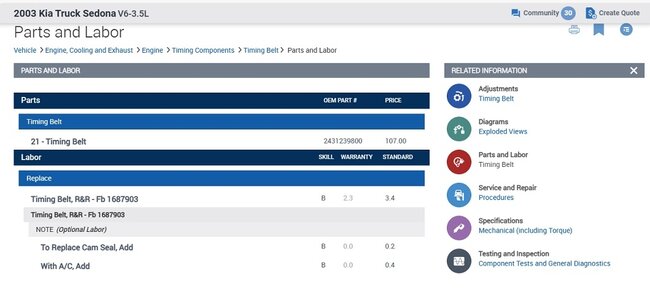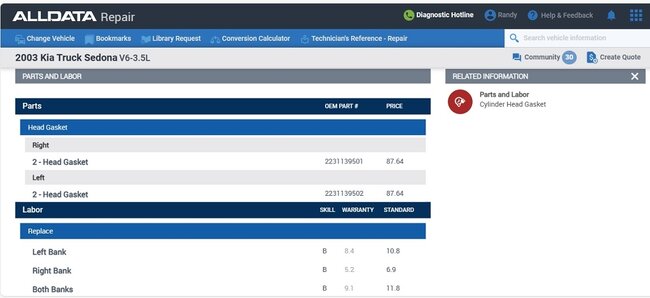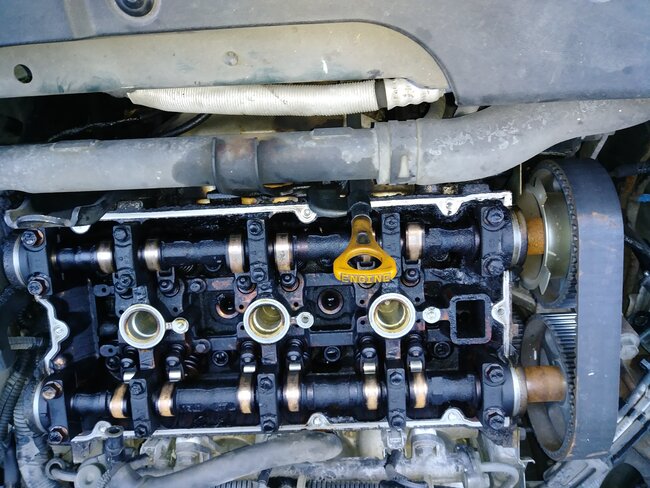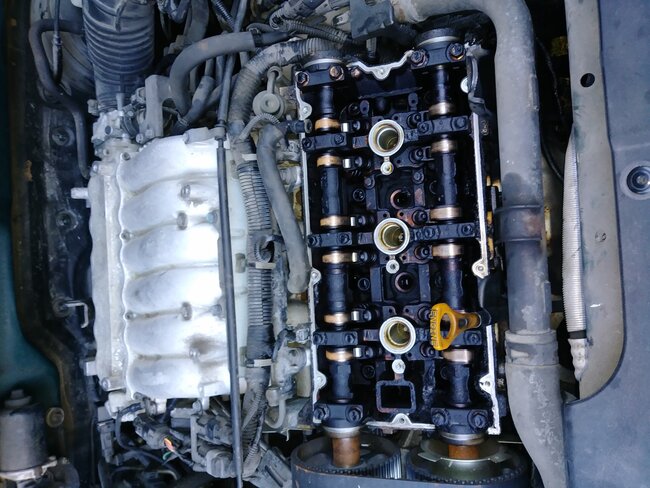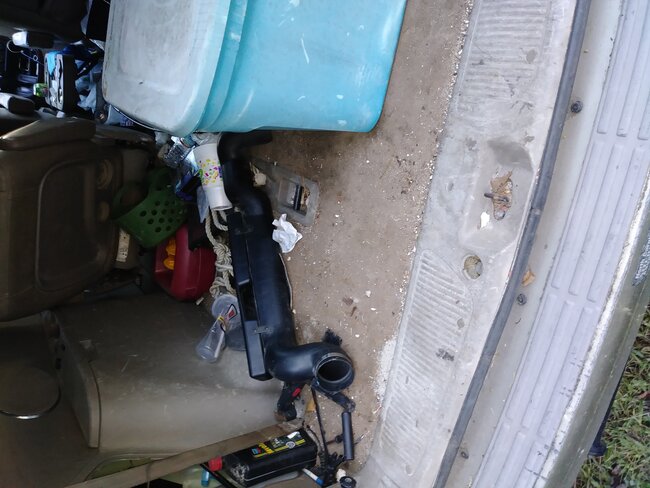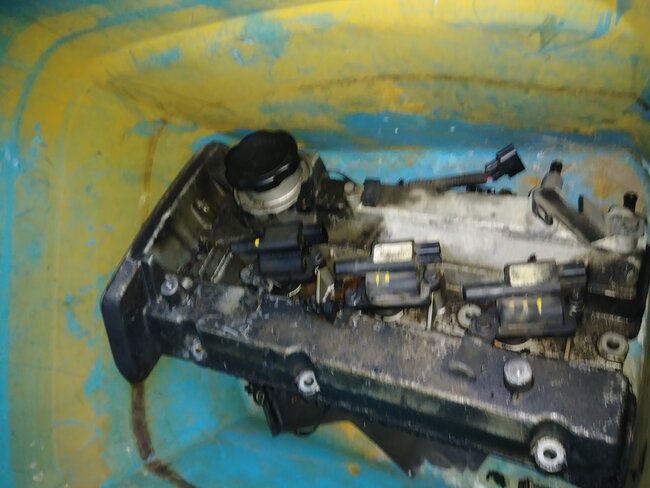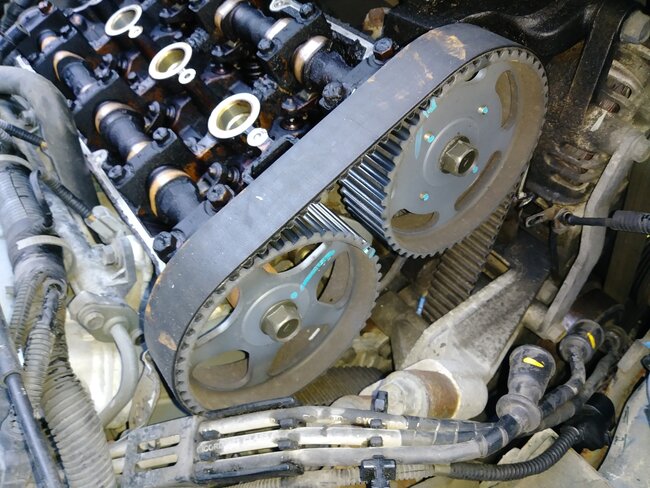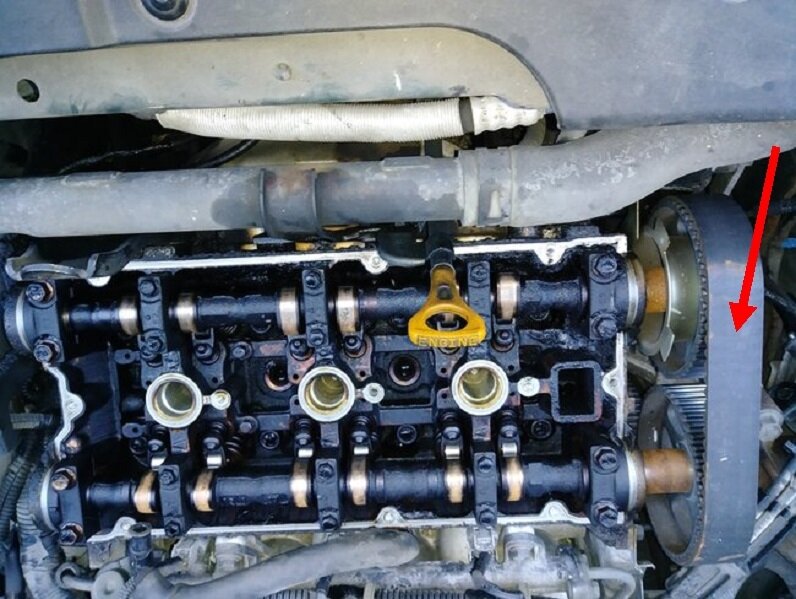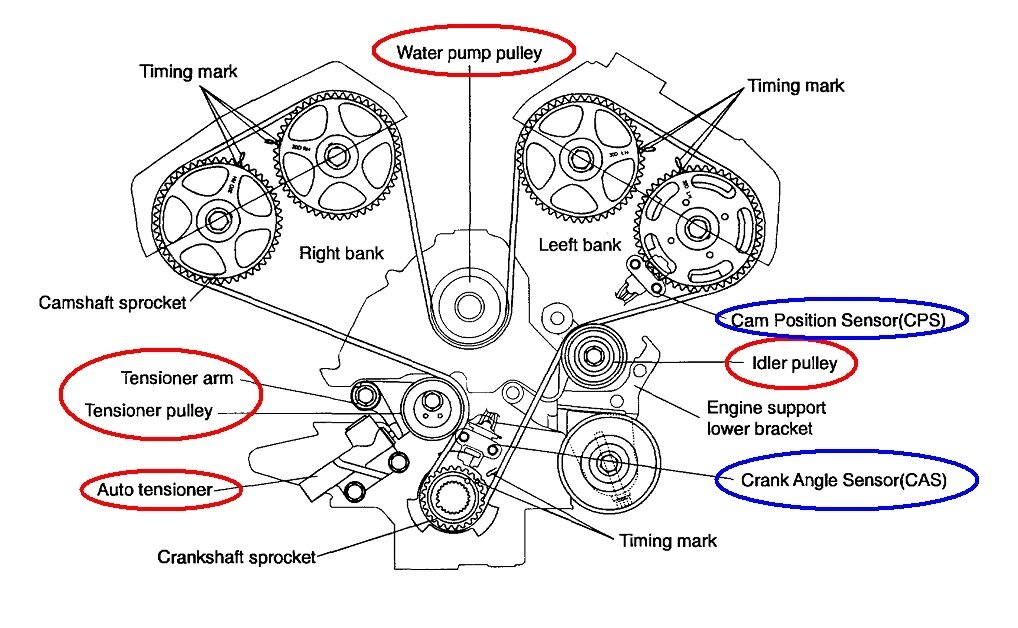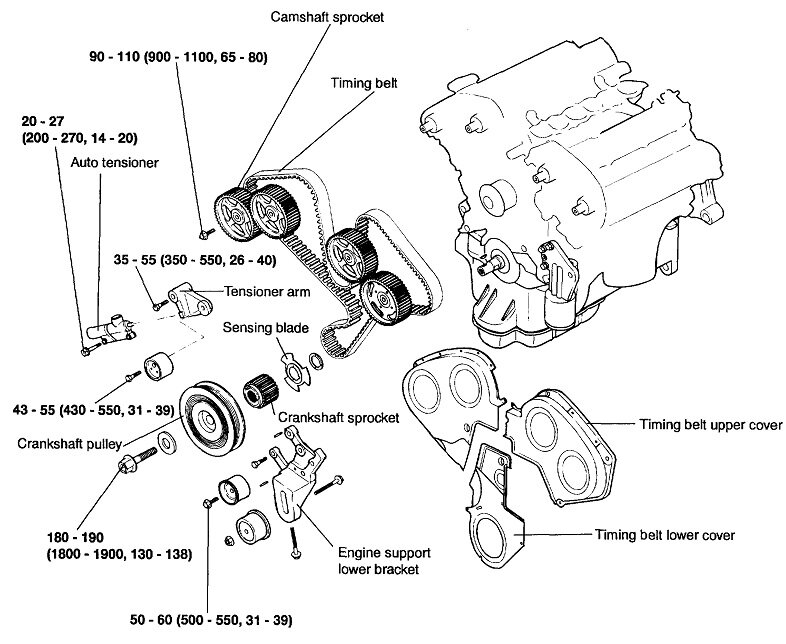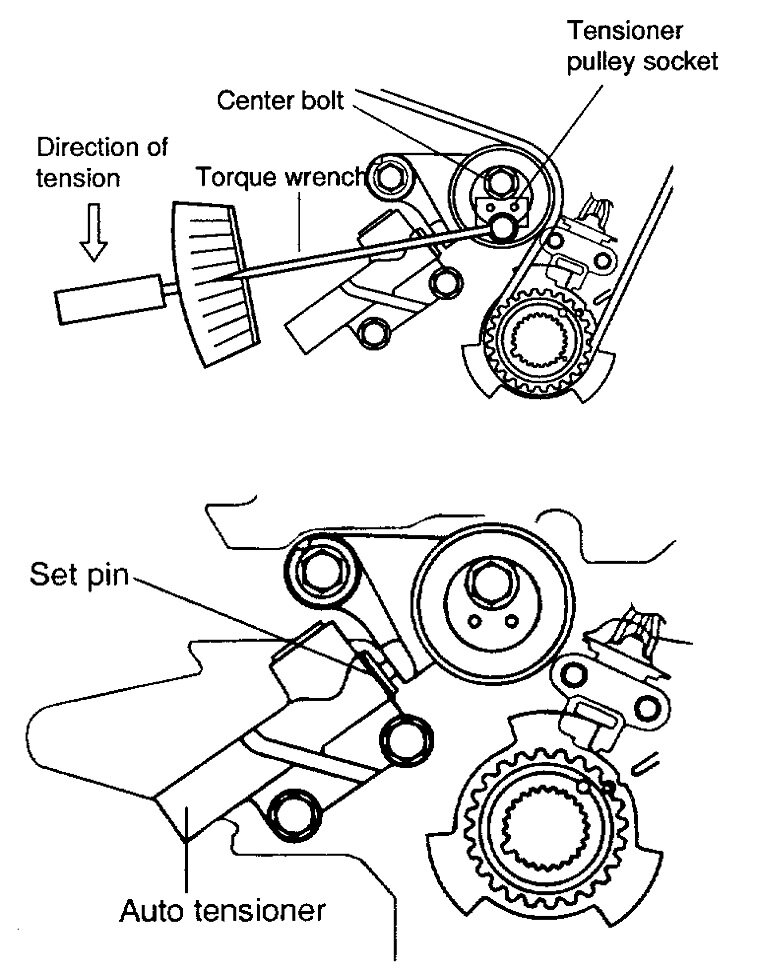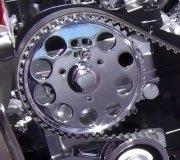Dandy. This is a legitimate time when you may be asked to order the parts. This way the first mechanic has no involvement with wrong or broken parts, profits on those parts, or responsibility for getting defective parts replaced. This saves you money if you don't mind taking the time.
My bigger concern now is the engine stalled, but now it does run. That proves the timing belt is not broken, but it could have jumped a tooth or two. For every comment you've made so far, I can come up with an argument as to why it has to be wrong, and I can come up with a reason it has to be right. In other words, I'm not helping you yet.
On some other models with interference engines, Chryslers, for example, if the timing belt jumps one tooth, the engine will still run pretty good, but it will be detected, the Check Engine light will turn on, and there will be a diagnostic fault code set for "camshaft and crankshaft sync". (The crankshaft drives the timing belt which drives the camshaft). If it jumps three teeth, valves will be bent. Before it gets that bad, if the timing belt jumps two teeth, the Engine Computer will shut the engine down to protect those valves. There is a totally different problem that makes it appear to the computer as though the timing belt jumped one and a half teeth. That's right on the borderline between the computer shutting down the engine or letting it run. The engine could stall for you, but run later for the mechanic. That's one source of confusion.
Next, since the second guy obviously worked on it, we can't be sure what he did or in what state he got the engine to run. Did he check the timing belt and reset it if it had jumped? If not, why is the engine running now? If he did, why did he go further and take the running engine apart? Throughout all this, has anyone read and recorded the diagnostic fault codes? That should always be one of the first steps. I should stop here and point out those fault codes never ever say to replace a part or that one is bad, as way too many people think. They only indicate the circuit that needs further diagnosis or the unacceptable operating condition. When a sensor or other part is referenced in a fault code, it is actually the cause of that code about half of the time. First we have to rule out wiring and connector terminal problems, and mechanical problems associated with that part.
There is a much more common cause of the symptoms as I know them so far. That is a failing crankshaft position sensor or camshaft position sensor. (Those are the two the computer uses to know when the timing belt has jumped a tooth). Both of those sensors commonly fail by becoming heat-sensitive, then they work again after cooling down, typically for an hour or more. This is very common on all car brands. Most often those sensors work fine while you're driving due to natural air flow keeping them cool. They're more likely to fail during periods of extended idling or slow-speed driving, or right after a hot engine is stopped, then restarted, as in when stopping for gas. Engine heat has time to migrate up to the sensors causing one to fail. This is the most common reason why an engine will stall for the driver, then restart later for the mechanic or tow truck driver.
To add to the frustration on everyone's part, both of those sensors often do not set fault codes just from cranking the engine. The computer needs more time to detect the missing signal, as when a stalling engine is coasting to a stop. Just cranking the engine later may not set that code again. In that case, we use a scanner to view live data the computer is seeing and responding to. In the case of Chrysler products, both sensors are listed with a "No" or "Present" to indicate whether the signals are showing up during cranking. We watch for the one that stays on "No" to know which circuit to diagnose. A similar method is used on other car brands to show the same information.
If I was the shop owner, and I found my mechanic disassembled the engine without prior approval from you, and that work was not necessary, I'd insist he reassemble everything at the shop's expense, but he would not be paid to do so since it was his fault. That is part of what is called "flat rate". That's a method of charging customers and paying mechanics' wages based on a large book that spells out what every procedure should take for time. As the shop owner, I would expect you to receive your vehicle back in the condition it showed up in. If new parts were installed already, it often takes just as much time to remove them and put the original ones back in. That's time the next jobs have to wait, or a couple of jobs that can't be taken in because the mechanic is tied up on your car. It may cost the shop less in the long run to just leave the new parts in, but they may try to negotiate a partial payment from you, especially if they can prove the old parts were defective or worn excessively. As a customer, I would feel obligated to pay for the parts, and I'd be grateful if I did not have to pay for the labor.
If you DID sign something, the next issue is whether the dollar amount agreed to was exceeded without your permission. Here in Wisconsin, once it is known that limit is going to be exceeded, it is sufficient to get approval to keep going over the phone. You don't have to run back to the shop to sign the repair order again. The service advisor will typically ask for your driver's license number so he has proof he really called you.
That leads to an area I'm much less familiar with. That's if you did sign the repair order agreeing to a dollar limit, that limit was not exceeded, but you refuse to pay for the work done. If this goes to court, this is why the shops are very strict about documenting everything in writing so they are protected. Before it goes that far, the shop owner will try to negotiate a plan that is acceptable to both parties, especially when there is a gray area as to who is in the wrong. They won't negotiate with customers who are just trying to get the bill lowered for no reason. In most states, a verbal exchange is not sufficient. Work to be performed should be in writing, meaning the repair order.
As a mechanic, I've had cases where I went too far without permission. This usually revolved around one of my specialties, suspension and alignment. I was paid 1.3 hours to perform a four-wheel-alignment, with an additional half hour per any rear wheel that had to be disassembled to install an alignment shim. It was the service writer's job to tell the customer the cost of the alignment, and the cost of additional rear-wheel work, if it was found to be needed. Very often the customer signed the repair order for the dollar amount to cover the basic alignment, but not anything additional for the rear wheels. It takes a lot of time to set up the alignment equipment and tear it down. That's part of the 1.3 hours. If I found a shim was needed in one rear wheel, I could stand there waiting for approval for a long time. That meant I'd be starting my next appointment up to an hour late. Often, while waiting for that approval, I just went ahead and put the shim in, then finished up the rest of the alignment. By the time I got the approval, the entire job was done, test-driven, and parked. Everyone was happy. If that approval never showed up, either because no one could be reached, or the customer was on a tight budget, no one made me take that shim back out. The customer got a better alignment, and no one asked them to pay for the extra part or service.
By the way, I had a reputation at the dealership for working much slower than everyone else, but I had almost no "comebacks", or complaints, and very high customer satisfaction. I made it up to the dealership owners by working through lunch hour and after hours. That alignment that paid me 1.3 hours often took up to two hours, but in ten years, not one single person there ever yelled at me for working too slowly. They valued the satisfied, repeat customers.
Enough for blowing my own horn. I was mulling over another comment of value last night regarding the $800.00. I don't know yet what that was supposed to cover, so I looked up the various procedures that might be part of this story. For a 2003 Sedona, replacing the timing belt is supposed to take 3.4 hours with an additional 0.4 hours if the vehicle has air conditioning. (There's more to take apart if there's AC). If a camshaft oil seal is found to be leaking, or if the mechanic thinks it's a good idea to replace it due to high mileage, that's another 0.2 hour. Total is four hours. The belt is listed as costing $107.00. That is usually cost from the dealer's parts department. Aftermarket sources usually cost less and are perfectly fine as far as quality. I know it sounds expensive, just like with veterinary bills and doctor bills, but I don't know how shops are able to survive when they "only" charge $125.00 to $150.00 per hour. I wrote up a list years ago of all the taxes, insurances, costs to meet government regulations, and all the expenses they have to pay before even considering wages and benefits. It was a two-column list that filled the page. Even if they charged $100.00 per hour, you'd have a $500.00 bill just for the timing belt. That is on the low side of other bills I've seen.
Now when you get to cylinder head gaskets, the "left bank" is listed as taking 10.8 hours. The right bank takes 6.9 hours. It is standard practice to do both sides at the same time, just like you do not buy just one shoe at a time. A large part of each cylinder head involves parts that have to be removed for each side, so those are only done once in the procedure. The total to do both cylinder head gaskets is 11.8 hours. To say that a different way, once the left bank is disassembled, it takes just one more hour to do the right bank at the same time. The head gaskets are listed as costing $87.64 each. I posted what we look at from the Flat Rate book below. By using that as a guide, it ensures you're quoted the same amount of time from multiple shops. The only variable is their hourly shop rate. Mechanics get paid by those listings too. If one invests in expensive, special tools, or advanced training, he might get done faster, but you pay the same amount. If he works slowly, like I did, or has less experience, it will take him longer than the times given, but he only gets paid for the times listed, and you do not pay more. Think of a barber with a set rate for a haircut. Doesn't matter if you're almost bald and he has to cut three hairs, or if you look like a hippie and he spends all afternoon slicing the locks off. Both pay the same amount.
The point I haven't made yet is replacing the head gaskets is usually over a $1500.00 job. Part of that job involves removing the timing belt, so that procedure is already partially done. If a new belt is needed, the additional labor time will be less than what's listed for just the belt. $800.00 isn't going to cover the head gasket job. That's why I'm questioning what was done already. There's usually a plastic dress-up cover on top of the engine, then the intake manifold must be removed. Those two parts alone can look like major engine work was done. The closest I can come to calculating a legitimate cost of $800.00 is to replace the timing belt and reassemble the intake manifold. I would sit down and negotiate that with the shop owner as it suggests the intake manifold did not need to be removed. The exception would be if that is what was necessary to inspect other parts, namely the lifter you mentioned, but that too is suspect. One collapsed lifter will make a ticking sound, and you might notice a slight misfire or engine vibration, but that will not cause the engine to stall.
What I'm hoping this boils down to is the legitimate repairs, once we know what those are, will cost around $800.00, leaving you with a properly-running engine. If that turns out to be true, neither mechanic is really at fault for their services. What does leave the sour taste is you were not kept informed of what was needed. We really dislike surprises except when we hand someone a final bill that's less than they were expecting.
I'm afraid I still might not have provided the help you need, so if you can post a photo of any paperwork, or if you can obtain a written list of the parts that need to be reassembled, those might help. One thing I do want you to watch out for is if other work is needed, lets say the cylinder head gaskets, it is to your disadvantage to insist the engine be put back together, then taken apart again by a third shop. You would be paying multiple times to have the same work done over and over.
I should mention too the water pump is driven by the timing belt. As such, it is no longer a one-hour job to replace it. Every conscientious mechanic in the world who has your best interest at heart is going to want to replace that water pump along with any critical tensioner or idler pullies and adjusters. Those parts and the additional labor aren't included in the labor times I posted. To not replace those parts while they're down in there would be like buying a whole new wardrobe, but continue wearing my old, smelly socks. It doesn't make economic sense to ignore them and take a chance one of them won't fail soon. Going in a second time would cost just as much as it does to do the timing belt.
Is it possible the parts you see in the back of the vehicle are actually from the front of the engine? A lot of stuff has to be removed to get to the timing belt. Often that is the only way to find the timing marks to inspect them to see if the belt has jumped a tooth. Based on the mileage you listed, the mechanics should be suspicious the belt does need to be replaced. All manufacturers have a recommended replacement interval to avoid expensive valve damage. Not too many years ago, Honda recommended their timing belts be replaced every 75,000 miles, and they commonly broke at 65,000 miles, leaving owners with very expensive engine repairs. Very few manufacturers list more than 100,000 miles as their recommendations.
Let me know as much as you can learn, then I'll do my best to figure out the best plan of attack.
Images (Click to make bigger)
Monday, October 23rd, 2023 AT 3:11 PM
